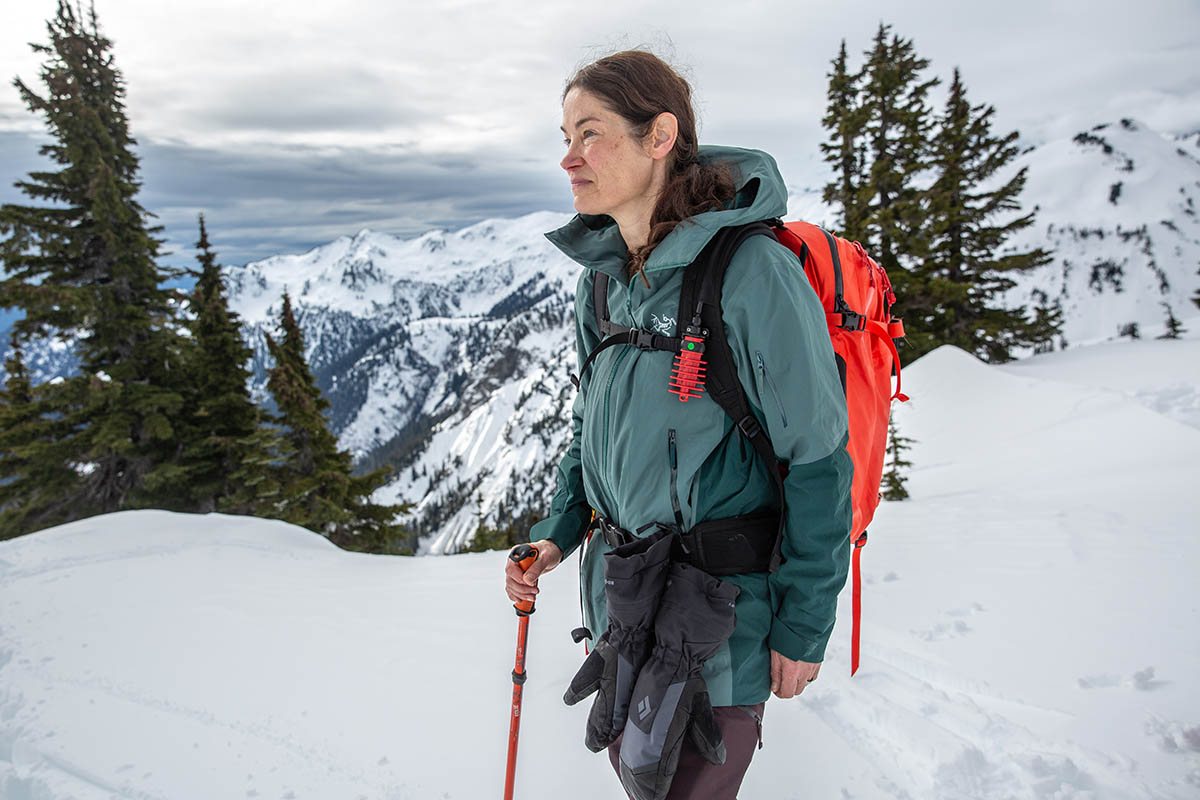
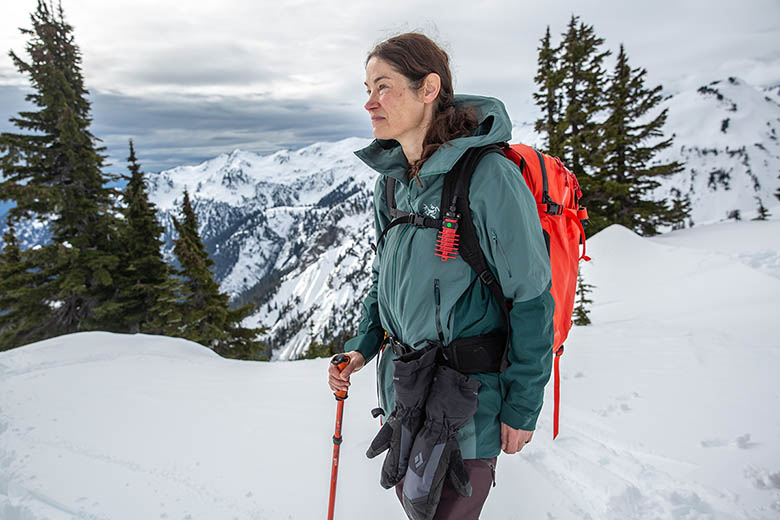
Price: $850
Waterproofing: 3L Gore-Tex ePE
Insulation: 80g Coreloft
What we like: Cozy warmth and dependable weather protection in a great-looking package.
What we don’t: Very expensive and not the most versatile option for crossing over between resort and backcountry use.
See the Women's Sentinel Insulated Jacket
Shell specialist Arc’teryx makes a ski jacket for just about every use, from resort-focused designs packed with premium down fill to streamlined, backcountry-ready offerings for those who prefer to earn their turns. The women’s-specific Sentinel Insulated attempts to bridge the gap, with a healthy dose of synthetic insulation packed inside a proven Gore-Tex shell. I spent last winter testing the Sentinel Insulated on and off piste and enjoyed the jacket’s cozy warmth, dependable protection, and high-quality look and feel. It’s undeniably expensive and too warm to wear during extended exertion but is a nice match for frequent resort use and cold-weather tours. Below I break down my experiences with the Sentinel Insulated Jacket. To see how it stacks up to the competition, check out our article on the best women’s ski jackets.
Editor’s note: Our review below covers the past-generation Sentinel Insulated Jacket. Arc’teryx released an updated version for the 2024-2025 season, which features a more premium 3-layer membrane, Gore’s soft C-Knit backer, and a nice sustainability upgrade. We haven’t had a chance to test the latest model yet but have included notes on relevant changes throughout our review below.
With a proven 2-layer Gore-Tex membrane and thick shell fabric, the Sentinel Insulated Jacket is a stalwart in rough and rowdy weather (note: The latest version swaps in a more premium 3L variation). For reference, the jacket handily withstood the full gamut of conditions last winter, from heavy snow to sleet, rain, and hail in temperatures ranging from around 5 degrees to mid-40s Fahrenheit. Combined with taped seams and a quality durable water-repellent (DWR) finish, the Sentinel has shown no signs of weakness and has kept me perfectly dry and comfortable in everything Mother Nature has thrown its way.
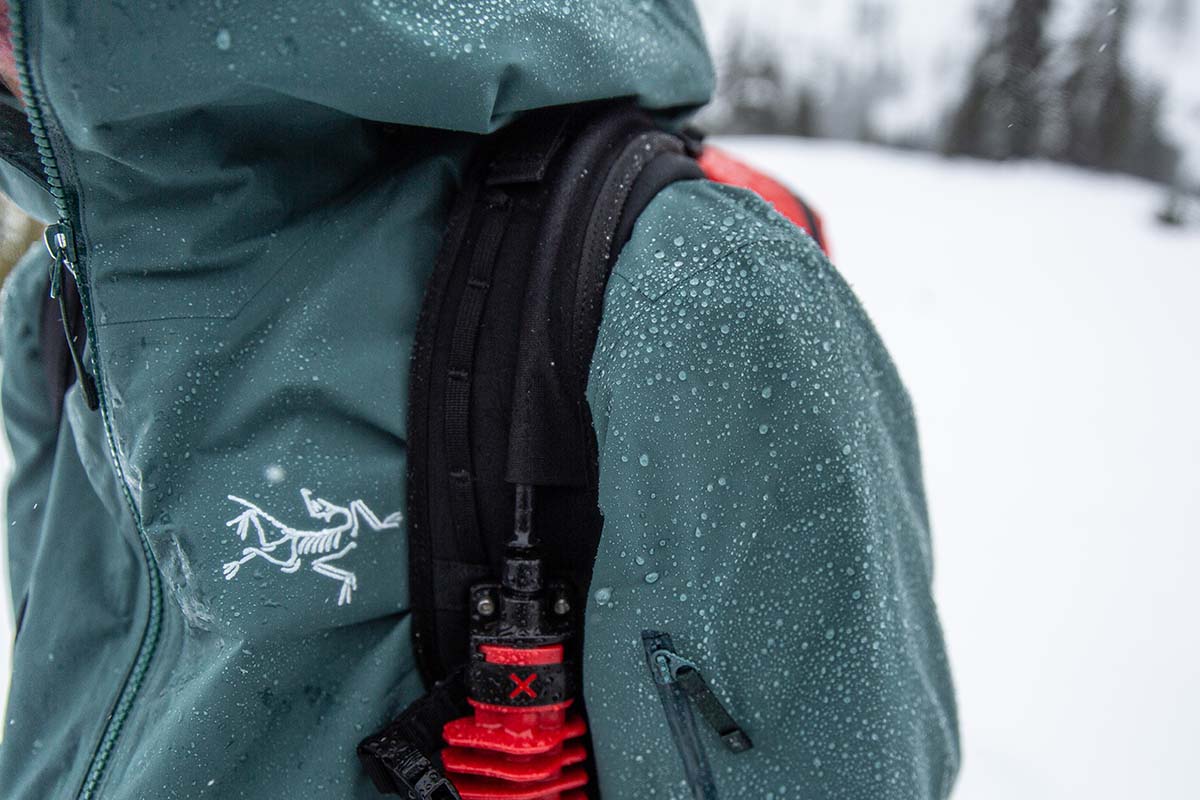
In addition to the trustworthy construction, Arc’teryx equipped the Sentinel Insulated with several protective features for battening down the hatches. First is the well-loved StormHood, which is helmet-compatible, easy to customize with three adjustment points, and very secure even in high winds. When cinched tight, the opening exposes only my ski goggles, nose, and upper lip, making it easy to tuck my face inside on blustery days in bitter cold. The tall collar also effectively blocks precipitation and wind from reaching my face, and the brim prevents snow and rain from accumulating on my forehead and goggles. You also get a powder skirt for sealing out snow at the waist, water-resistant zippers that I trust enough to protect electronics, and Velcro cuff adjustments that easily slide under gauntlet-style gloves. Finally, the jacket’s generous center back length (30.7 in. for my women’s small) means there’s ample coverage, even when I’m sitting down.
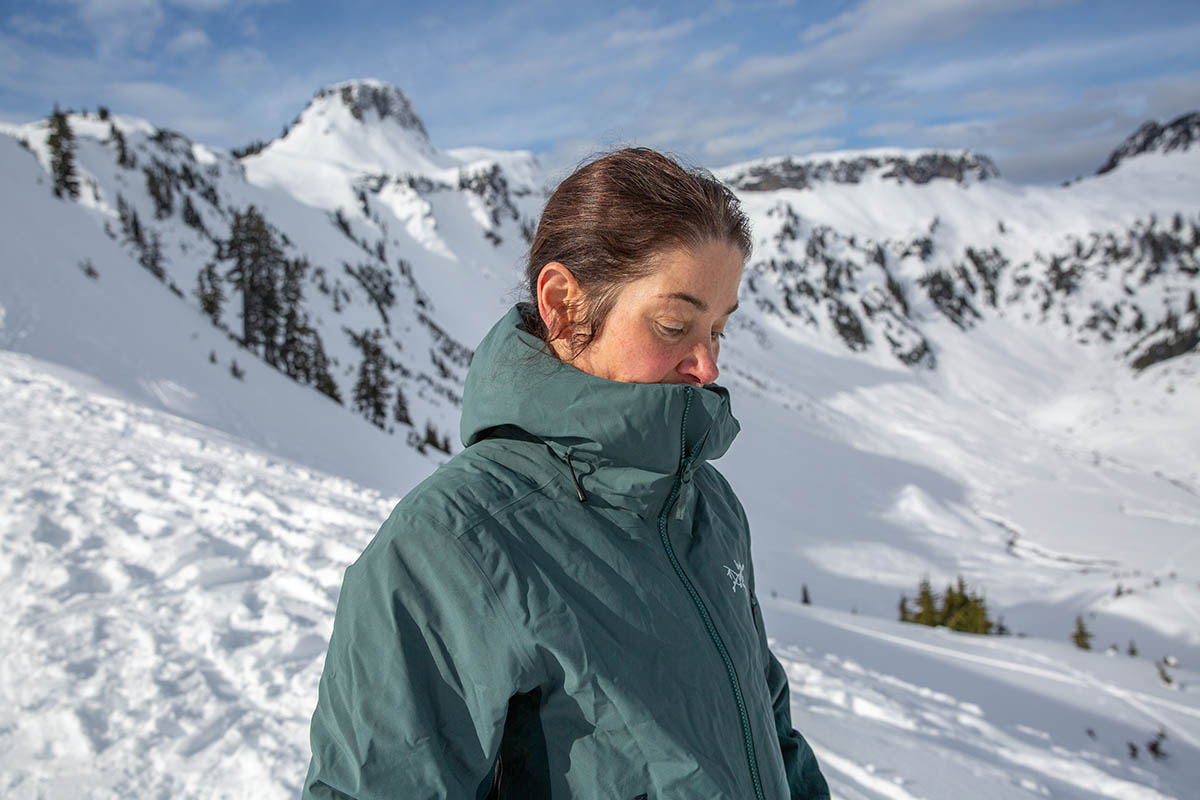
Warmth is one area where the Sentinel Insulated truly shines. For insulation, Arc’teryx opted for 80-gram Coreloft, which is their go-to synthetic fill that does a nice job mimicking the cozy warmth and loftiness of down. It’s true that down is warmer for the weight and more compressible to boot, but synthetic fill will continue to insulate when wet, making it the better choice for inclement weather and activities when you’re likely to work up a sweat (like backcountry skiing). In practice, the Sentinel Insulated kept me perfectly cozy throughout testing, adding a just-right amount of warmth for resort use as well as transitions and descents in the backcountry. To be sure, those who exclusively ski inbounds and run cold may want to consider a warmer, down-insulated design like Arc’teryx’s own Nita Down Jacket, but I’ve found that the Sentinel strikes a nice middle ground: warm enough to take the sting out of truly cold temperatures but not so much that I overheat with moderate exertion.
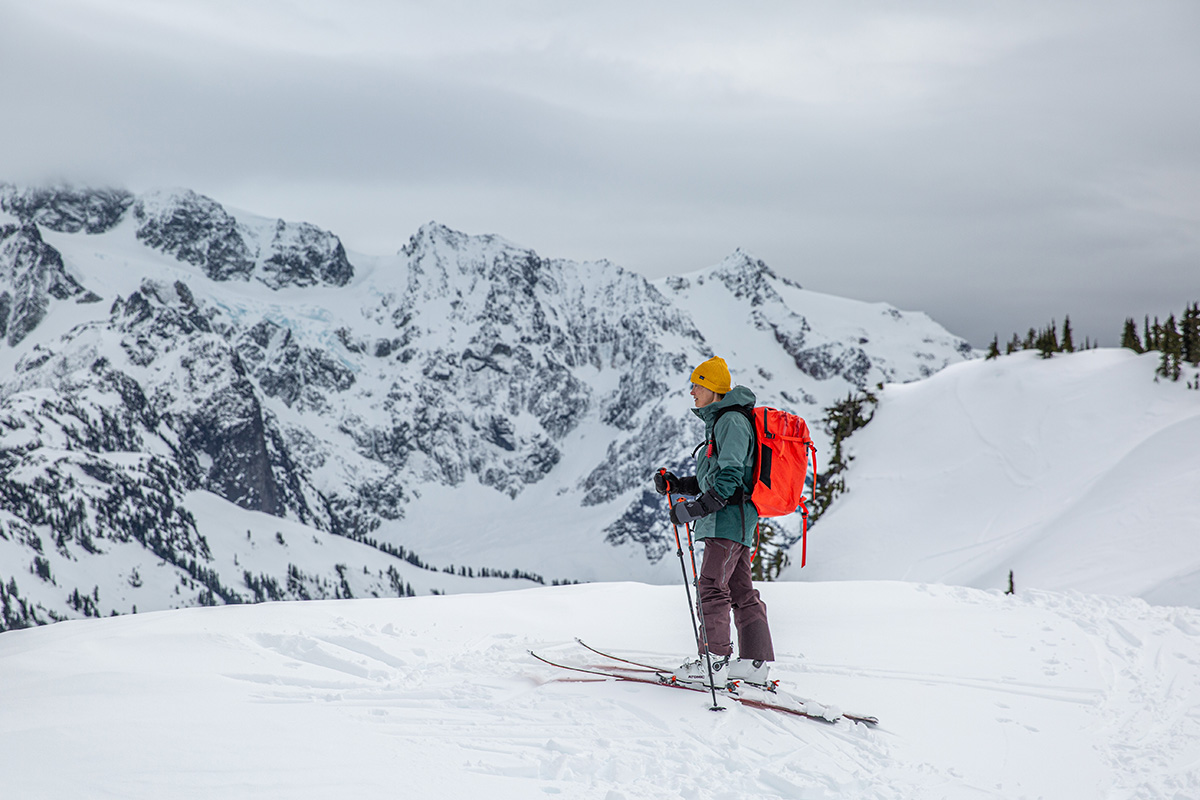
Like the uninsulated Sentinel Jacket, the Sentinel Insulated scores high marks in the comfort department. For starters, the Coreloft insulation is extremely plush and does a nice impression of down’s lofty warmth. The outer shell is also relatively supple and quiet—a nice upgrade from the crinkly and stiff feel common among traditional 3-layer hardshells—and the lining is soft against the skin and glides easily over baselayers and midlayers (note: The latest version of the jacket tacks on Gore’s C-Knit backer, which is even suppler). Finally, overall mobility is excellent thanks to the articulated elbows and relatively roomy fit, allowing me to comfortably transition, hoist my pack, or load gear into our van with no restriction to movement.
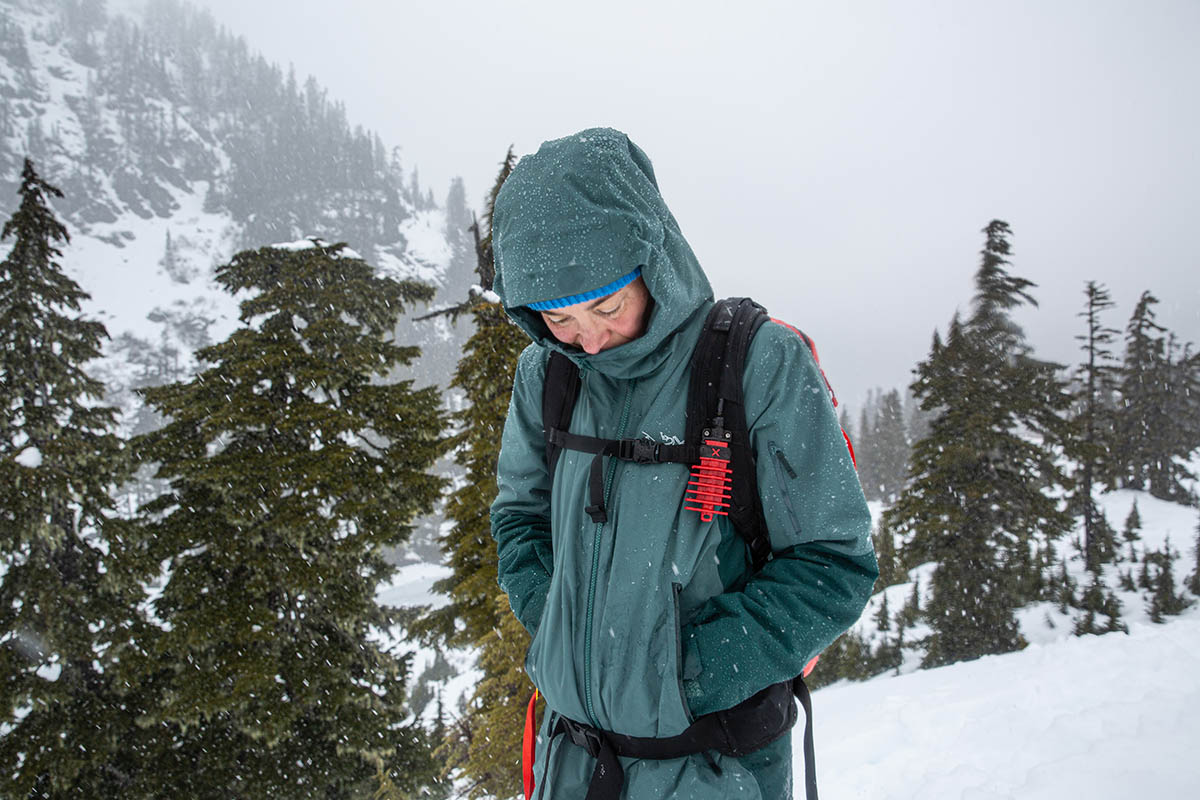
The Sentinel Insulated is designed for both resort and backcountry use, but I’ve found it’s best suited for the former due to the lack of breathability. The first culprit is the 2-layer membrane, which is more prone to trapping heat than an upgraded 3-layer design (for more on the differences, check out our article on Ski Jacket Construction: 2L vs. 3L). While great for warmth, the Coreloft insulation also doesn’t help with breathability, although the lining is effective at wicking sweat and avoids the damp, clammy feeling common among cheaper designs. And while you do get pit zips for dumping excess heat, they're lined with mesh, which limits the amount of air that can flow through.
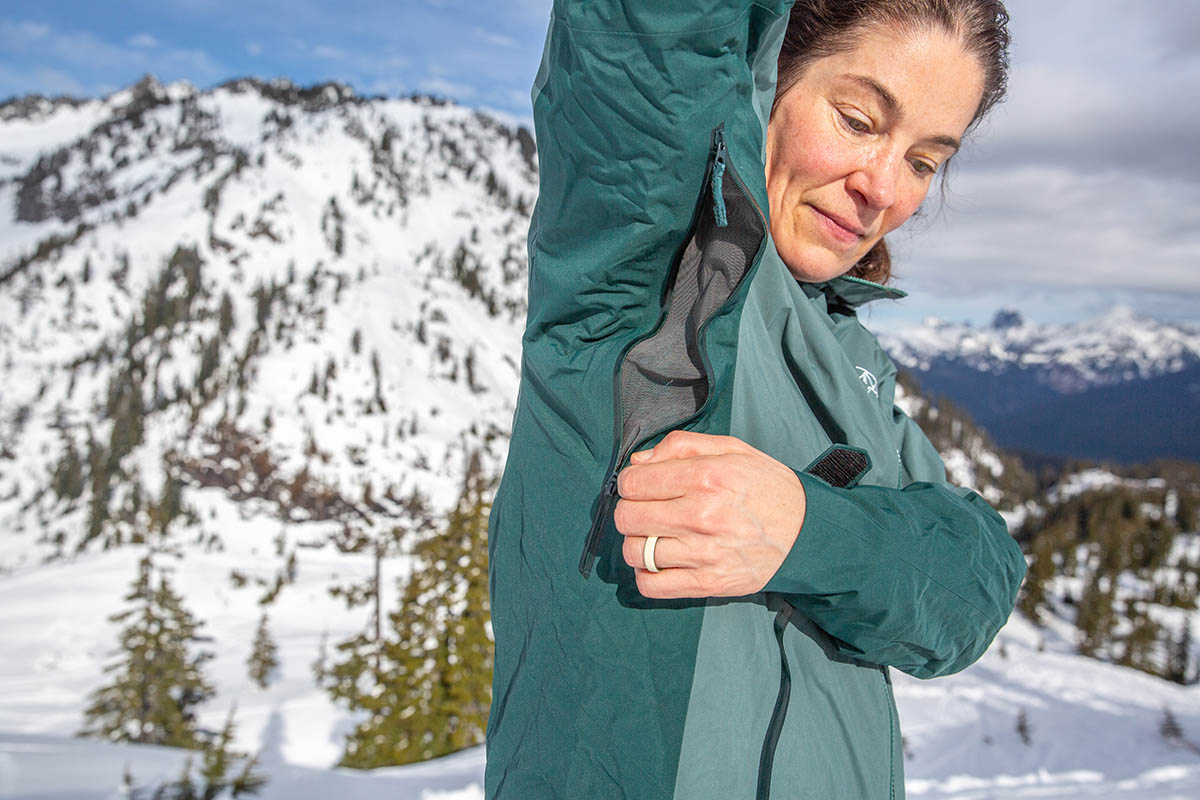
In practice, I’ve found the Sentinel Insulated Jacket to be a nice companion for backcountry transitions, short yo-yo laps, and descending in cold conditions, but extended bouts of exertion will cause things to heat up quickly. I was able to keep it on while skinning uphill during frigid, blizzard-like conditions, but even then, I found myself opening up the pit zips and unzipping the two-way main zipper a few inches (from the bottom up) to maximize airflow. If breathability is a priority, uninsulated 3-layer shells lead the pack, but even a design like Arc’teryx’s own Rush Insulated, which uses Gore’s more breathable (but not fully waterproof) Infinium membrane, will be a major step up. (And the latest version of the Sentinel Insulated should also be a better breather due to its upgraded 3L membrane.)
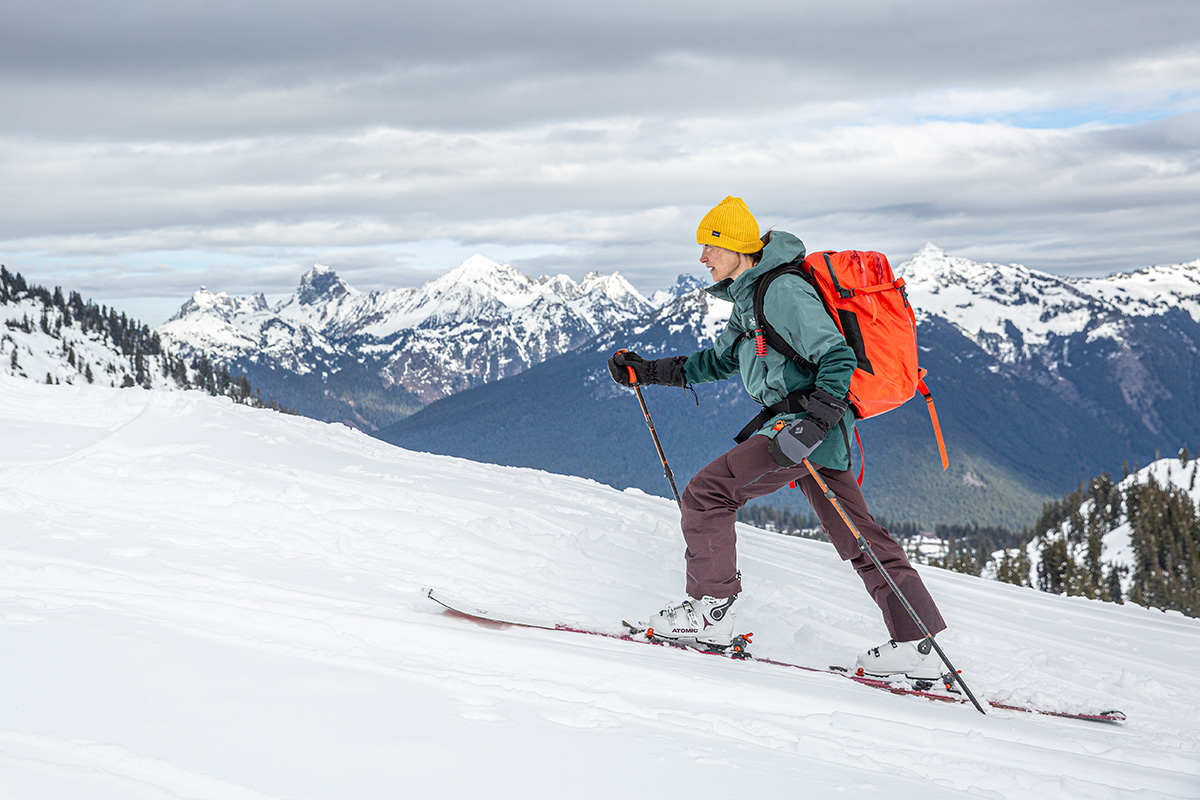
As expected from a high-end Arc’teryx piece, the Sentinel Insulated Jacket is built to last. For starters, the shell fabric is very substantial at 80-denier (D) and has handily withstood everything I’ve thrown at it, including being haphazardly stuffed into and pulled out of my pack frequently. Despite my less-than-gentle care, the jacket looks brand new, and all the smaller components are functioning flawlessly, from the smooth-operating toggles and zippers to the clean stitching and effective DWR coating. Impressively, there’s also no evidence of rubbing from the straps of my pack. Given my experiences thus far, I have no qualms about wearing the Sentinel Insulated around sharp ski equipment and expect it to have a long and healthy lifespan.
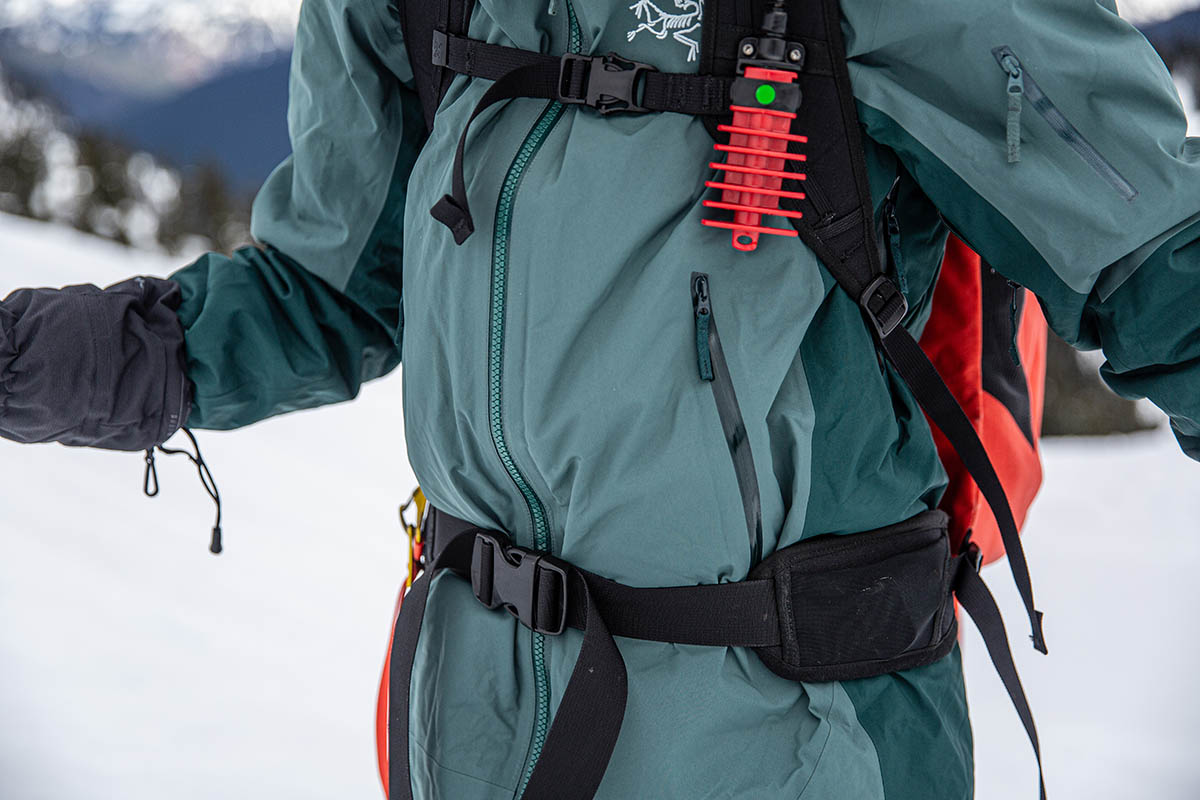
Insulated ski jackets aren’t often praised for being lightweight, but the Sentinel Insulated is on the more competitive end of the spectrum at a reasonable 1 pound 9.8 ounces for my women’s small (the latest version is listed at an almost identical 1 lb. 9.7 oz.). For reference, it lands between Arc’teryx’s resort-oriented Nita Down Jacket (2 lb. 0.9 oz.) and more backcountry focused Rush Insulated (1 lb. 2.2 oz.), which is logical given the jacket’s crossover intentions. And it’s worth noting that you can go much heavier in the insulated space, with designs like Helly Hansen’s Alphelia checking in at over 2 pounds. In other words, the Sentinel Insulated balances its priorities well and can easily pull double duty on the occasional tour. Plus, it packs down into its hood to about the size of a volleyball, which isn’t bad considering it takes the place of both a shell and midlayer.
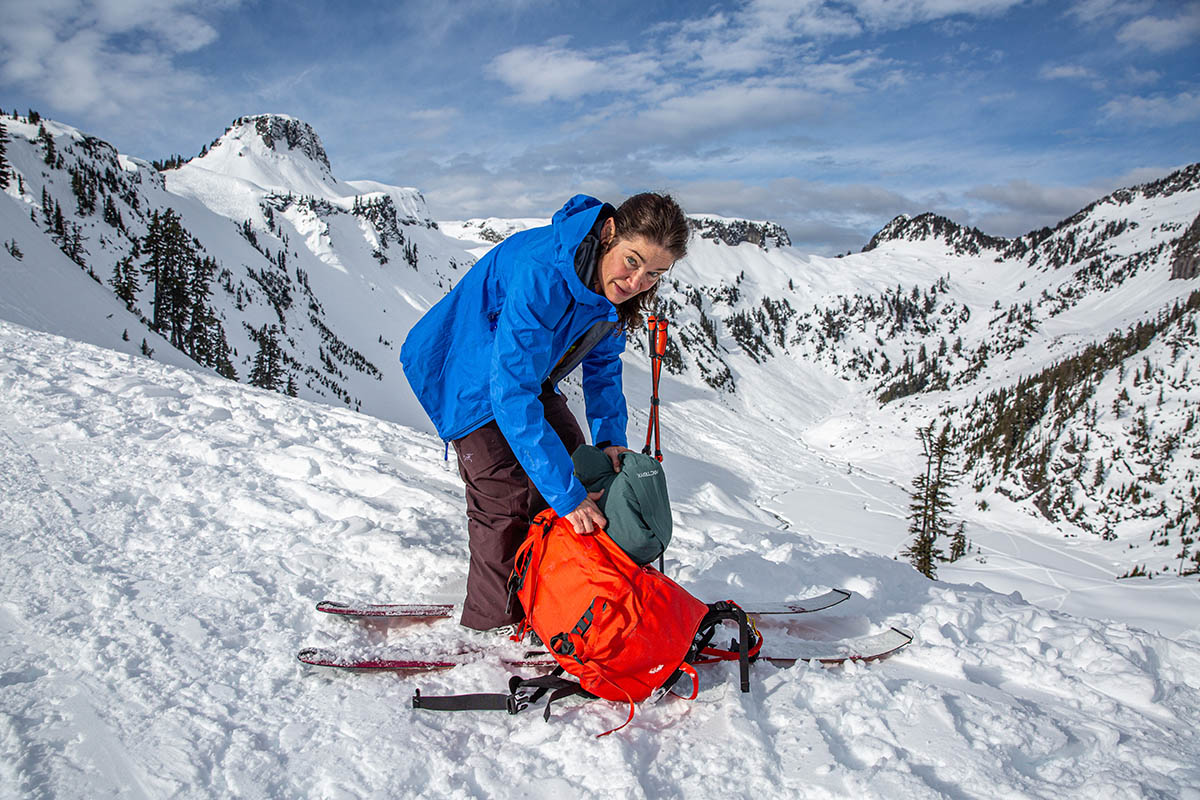
I say this quite frequently about Arc’teryx’s StormHood design, but it remains my favorite in the market. As expected, the Sentinel’s hood fits comfortably over a ski helmet with no restriction to movement and is easy to adjust via three toggles: one at the back for adjusting the brim and two at the base of the collar for tweaking the aperture. Together, the drawcords are effective at cinching things down with or without a helmet and keep the hood securely in place, even in strong winds.
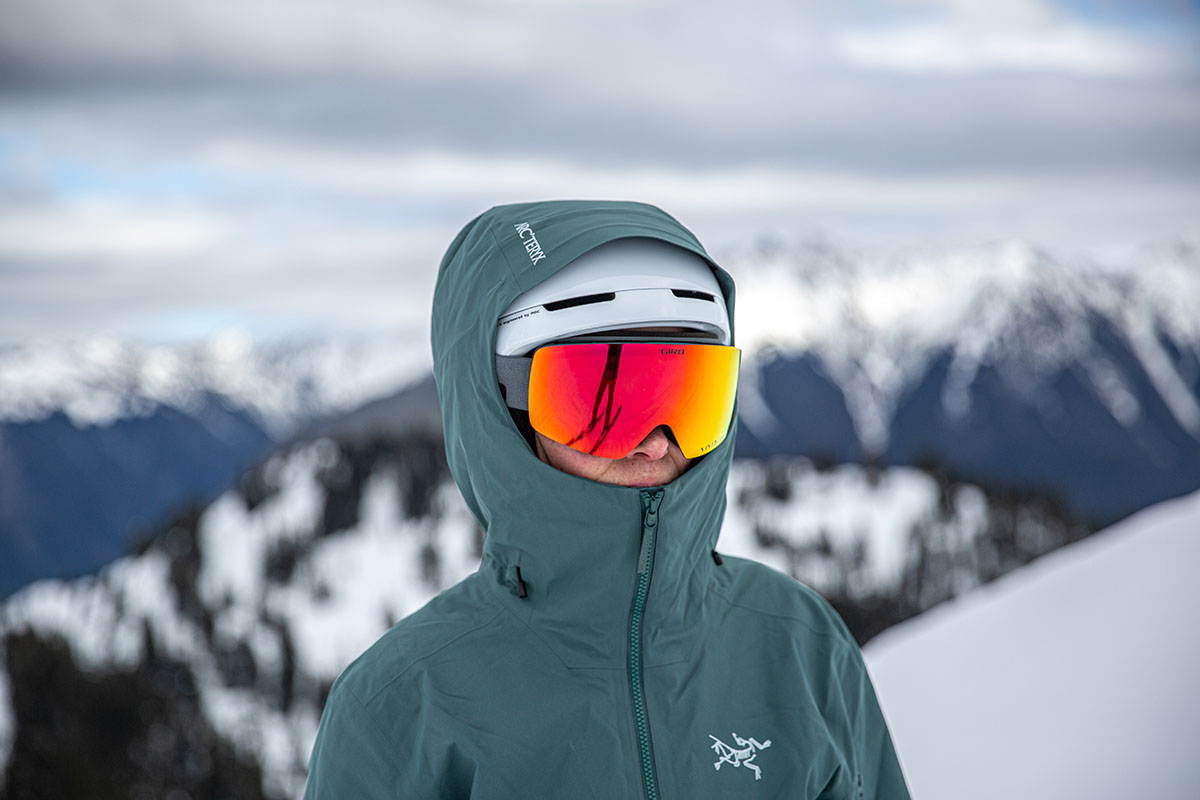
Like most ski-specific jackets, the Sentinel Insulated boasts an integrated powder skirt for sealing out snow and drafts at the waist. It also attaches to compatible Arc’teryx pants via two Slide’n Loc closures below the waistband at the back. And if you don’t plan to pair the Sentinel with Arc’teryx snow pants, the skirt has a grippy elastic at the back that prevents it from flopping around with two sets of snaps for dialing in fit. For reference, I paired the Sentinel Insulated Jacket with several brands of snow pants throughout the season and had no issues with riding up or snow creeping in at the waist.
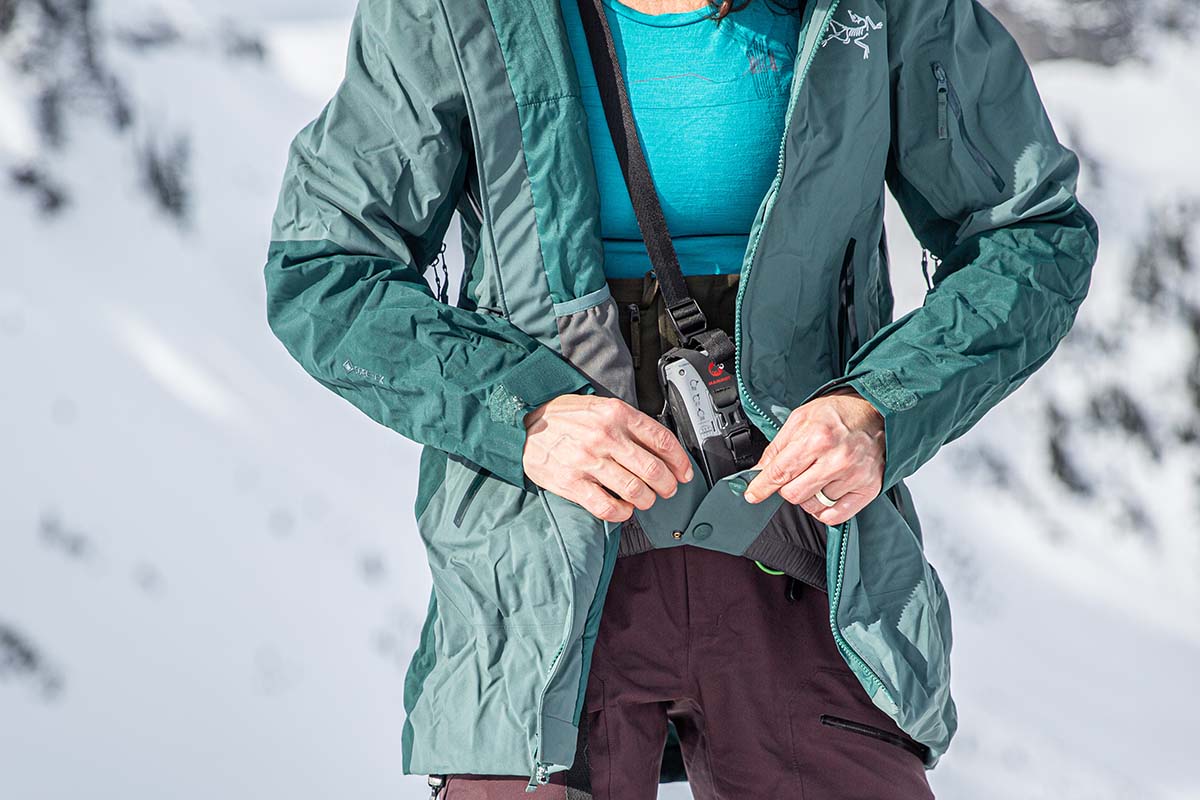
Like the standard Sentinel Jacket that I tested last winter, the Sentinel Insulated Jacket features five total pockets for divvying up the essentials. These include two hand pockets, an internal mesh dump pocket, an interior zippered pocket, and a zippered pocket on the left arm for a ski pass. The hand pockets are insulated on both sides and big enough to comfortably fit gloved hands, although the zippers are partially obscured when wearing a pack, requiring me to pull the jacket up to shove my hands in. On the inside, the dump pocket is great for stashing goggles but not particularly secure for valuables like sunglasses or a phone—I’ve almost lost my sunglasses a few times due to them falling out, which is likely a result of the smooth liner. Thankfully, the zippered pocket on the other side offers more secure storage for these types of items, although I wish Arc’teryx had included an exterior chest pocket for easier access.
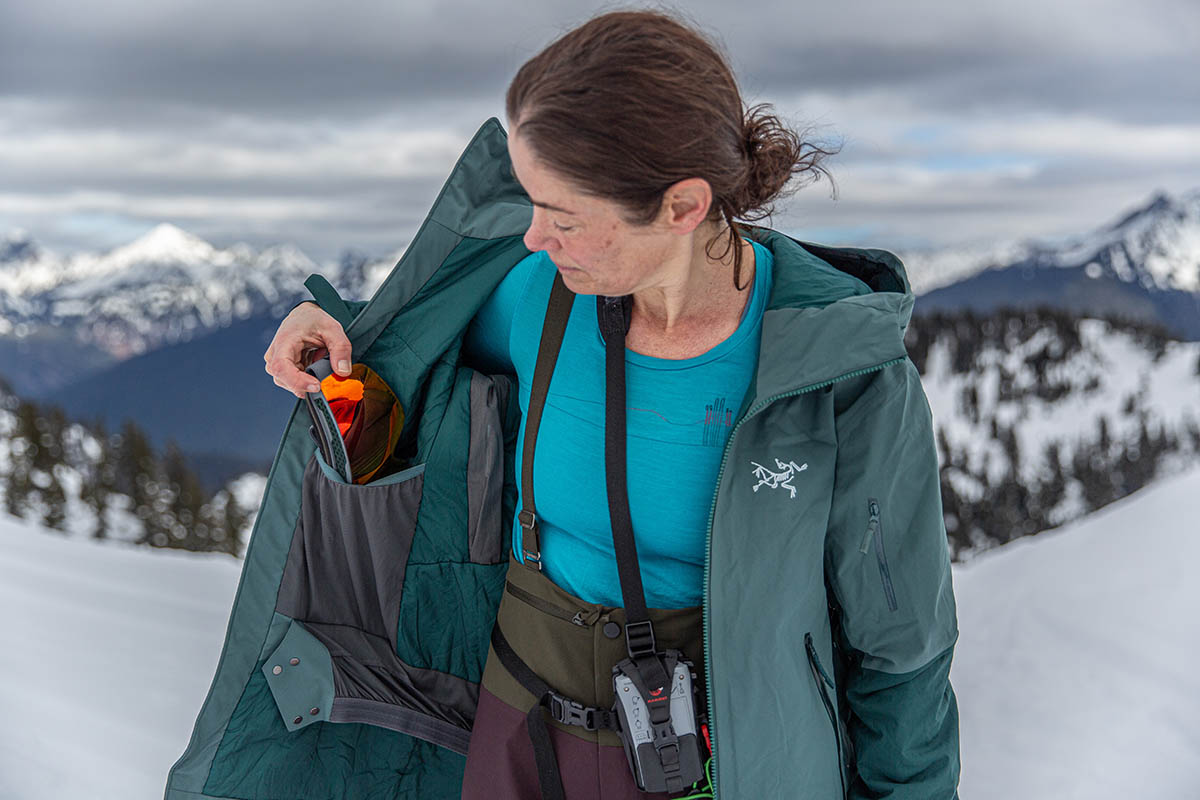
I opted for my usual women’s size small in the Sentinel Insulated Jacket and was happy with the overall fit. For reference, Arc’teryx dubs the shell a “regular” fit, which means it’s intended to accommodate layers underneath but not so roomy that it looks or feels overly bulky. While a little bigger than I’m used to, I came to appreciate the freeride aesthetic and unrestricted freedom of movement. I also like that I can fit bulky layers underneath on particularly cold days, with two of my go-tos being the Arc’teryx Proton Heavyweight Hoody and Rab Mythic G Down Jacket. As I touched on above, the Sentinel also has a generous center back length that keeps me protected on cold chairlift rides, and the two-way main zipper helps mitigate any issues with bunching when sitting down or taking full strides while skinning.
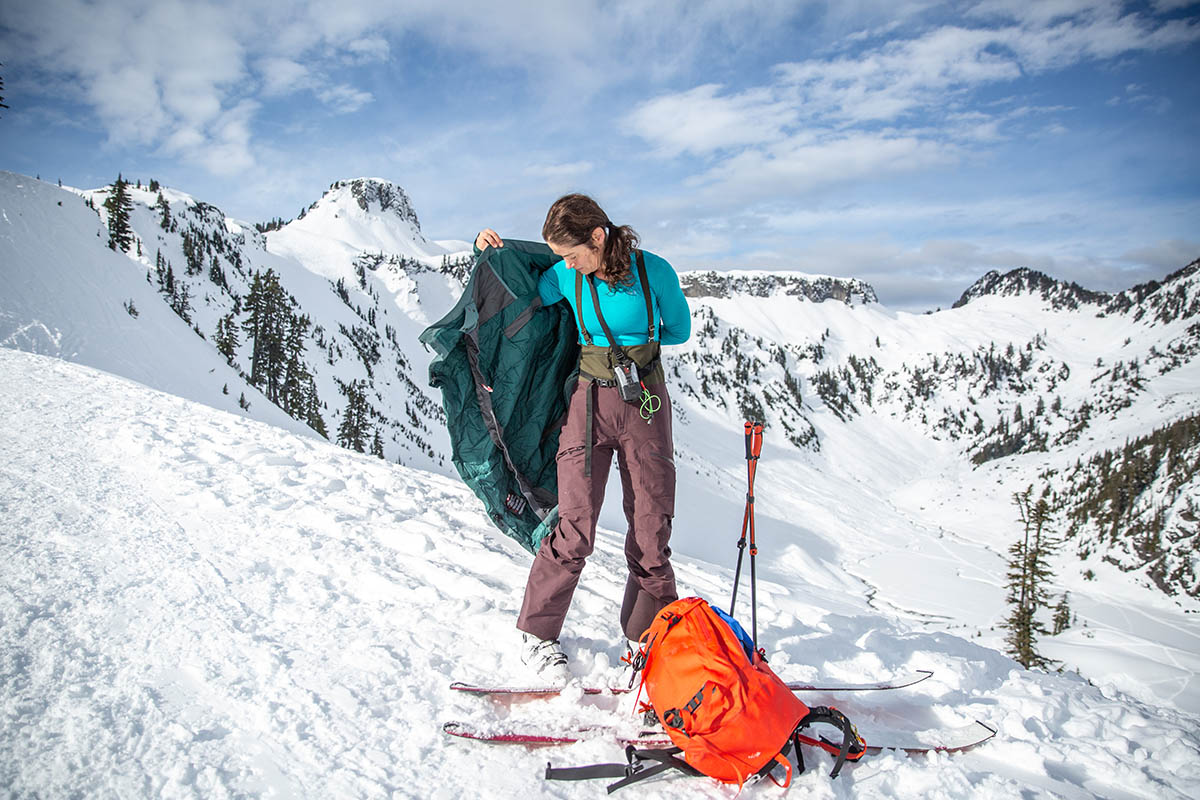
The outdoor industry has seen a sizable uptick in the use of sustainable practices of late, and Arc’teryx is no exception. In this case, the Sentinel Insulated Jacket features recycled Coreloft insulation along with bluesign-approved materials, which have been sourced and produced to minimize their overall impact on the environment. The jacket is also dope-dyed to reduce the amount of water and energy consumption during the dyeing process. Finally, the latest version of the jacket boasts Gore’s latest ePE membrane that’s made without PFAS (short for per- and polyfluoroalkyl substances), which are known as “forever chemicals” and under scrutiny across several industries for their negative impacts on human health and the environment.
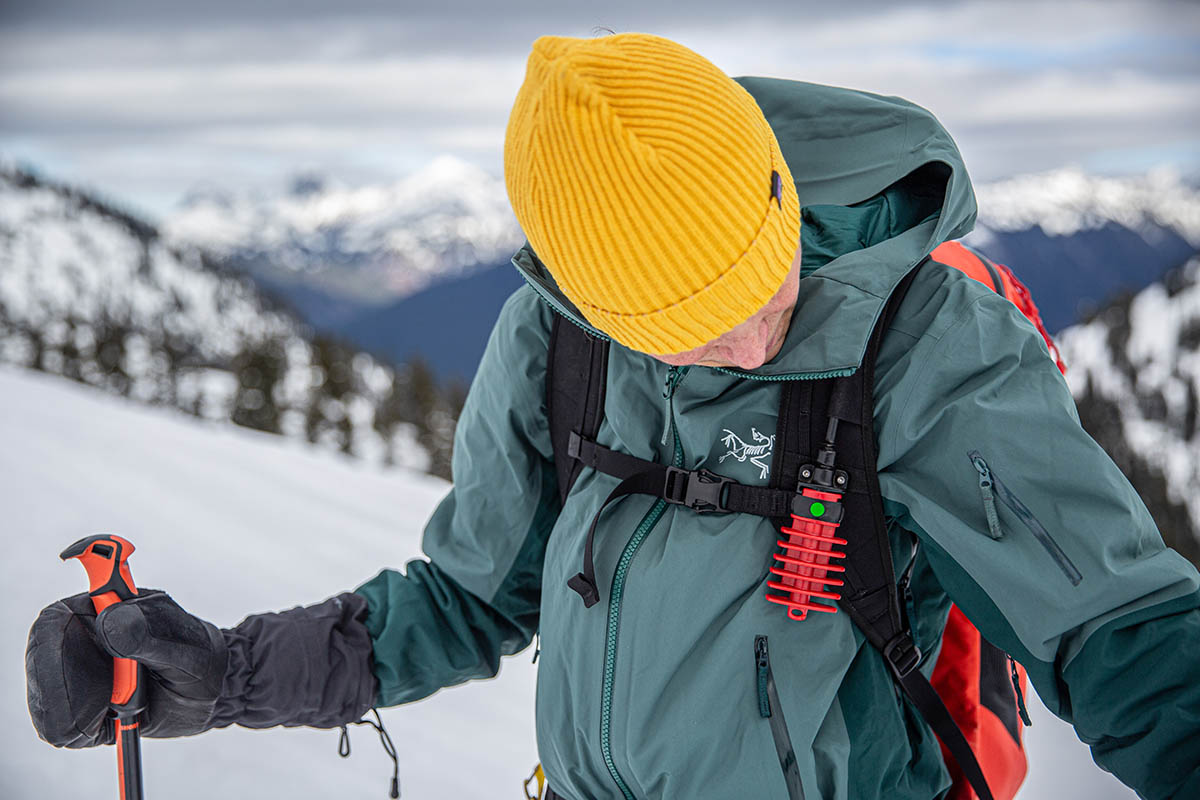
My review above covers the Sentinel Insulated Jacket, which is part of Arc’teryx’s women’s-specific Sentinel collection. Other styles in the lineup include the standard Sentinel Jacket, which is uninsulated and crosses over nicely between resort and backcountry use (see my in-depth review here), along with the roomier Sentinel Relaxed Jacket and half-zip Sentinel Insulated Anorak. To complete your kit, Arc’teryx also offers the Sentinel Bib Pant, Sentinel Relaxed Pant, and Sentinel Insulated Pant. On the men’s side, the Sabre is the Sentinel’s counterpart and also offered in several variations depending on your warmth and styling preferences. These include the largely similar Sabre Insulated Jacket, standard Sabre Jacket, Sabre Relaxed Anorak, and Sabre SV (short for “severe weather”) Jacket. For bottoms, the lineup includes a similar mix of bib and pant options.
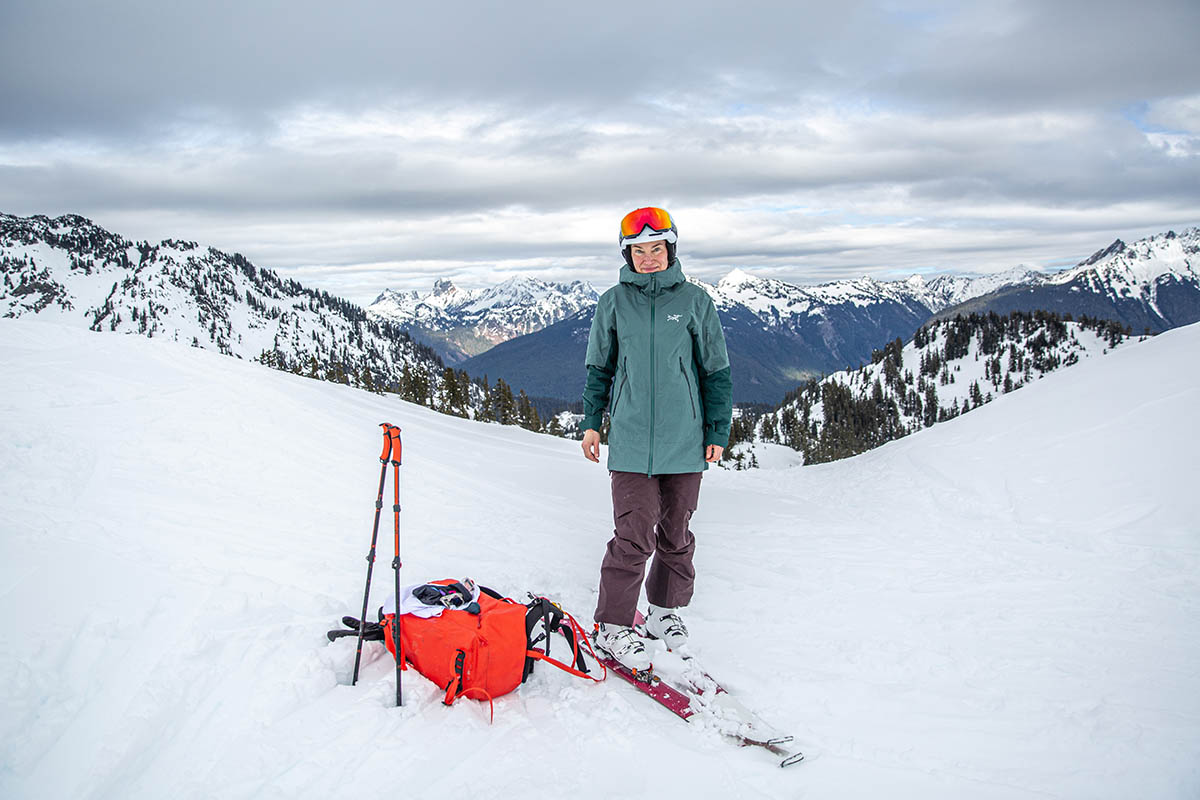
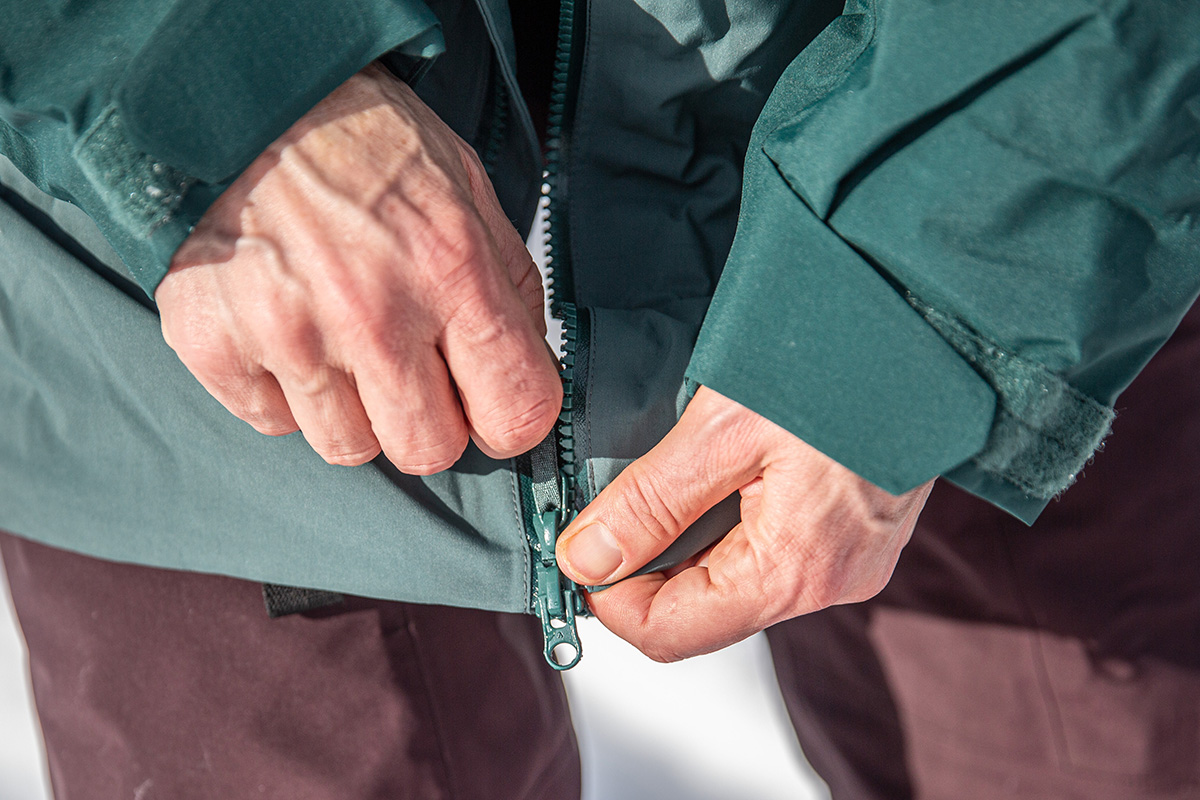
| Jacket | Price | Best For | Insulation | Waterproof | Weight |
|---|---|---|---|---|---|
| Arc'teryx Sentinel Insulated | $850 | Resort/BC | 80g Coreloft | 3L Gore-Tex | 1 lb. 9.7 oz. |
| Helly Hansen Alphelia | $475 | Resort | 100g & 133g PrimaLoft | 2L Helly Tech Pro | 2 lb. 3.3 oz. |
| Patagonia Ins. Storm Shift | $549 | Resort | 60g & 100g Thermogreen | 2L Gore-Tex | 1 lb. 14.3 oz. |
| Arc'teryx Rush Insulated | $800 | Backcountry | 100g Coreloft | 2L Gore-Tex Infinium | 1 lb. 2.2 oz. |
| Arc'teryx Theriss Down | $950 | Resort | 750-fill down & 80g Coreloft | 2L Gore-Tex | 1 lb. 9.0 oz. |
The Sentinel Insulated is a premium women's ski jacket that nicely balances warmth and weather protection for frequent resort riders but is no small investment at $850. For a major step down in price, Helly Hansen's Alphelia is our top-rated resort pick this year and stacks up very competitively. Like the past-generation Sentinel that I tested, the Alphelia is a 2-layer design but swaps in Helly Hansen’s in-house Helly Tech Professional membrane, which we’ve found to be on par with Gore-Tex in terms of wet-weather assurance but a step down in breathability. The Helly Hansen also uses thicker (100g and 133g) synthetic insulation for a boost in warmth, features a detachable hood, and comes with more storage than the Sentinel, resulting in a noticeable boost in weight. This makes the Sentinel the better crossover option for use both inside and outside the ropes, but those who ski exclusively inbounds can save a good chunk of change with the Alphelia.
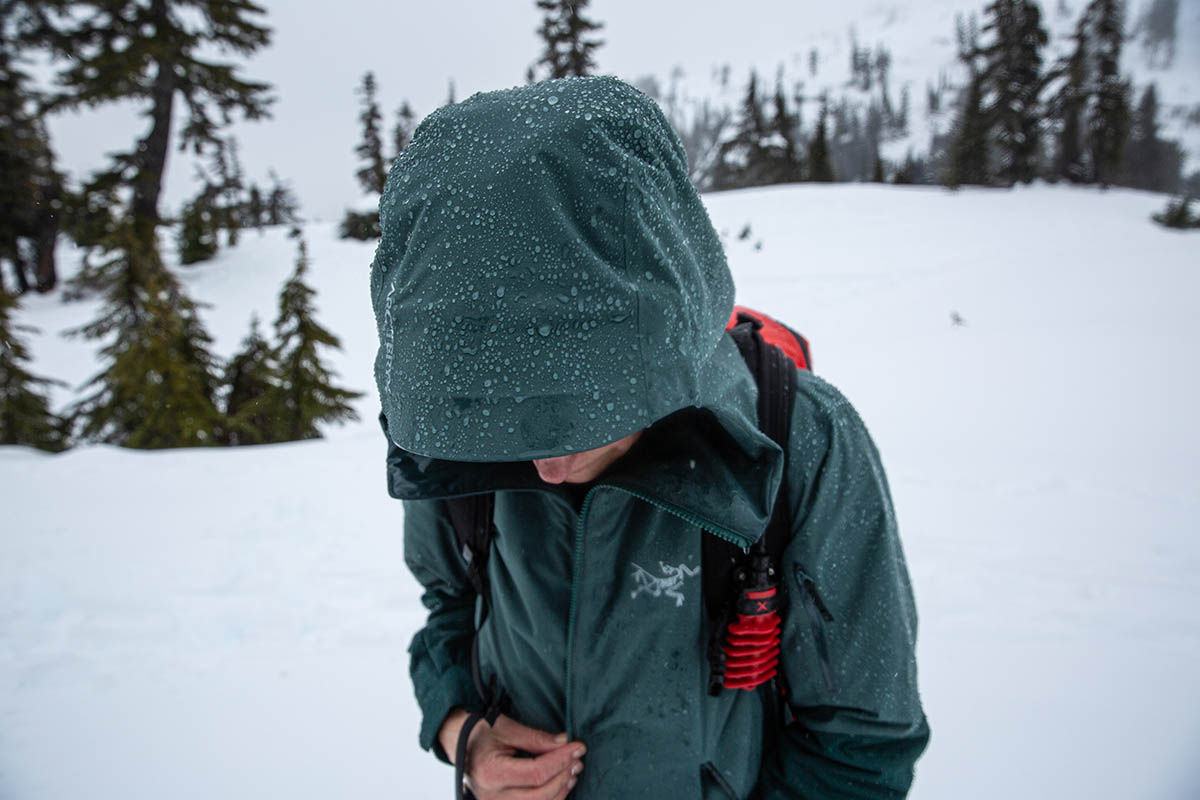
Next up is Patagonia’s Insulated Storm Shift Jacket, which retails for $549 and boasts a 2-layer Gore-Tex construction for sealing out weather. Like the Sentinel, the Storm Shift also packs in a modest dose of insulation (60g and 100g synthetic Thermogreen), has a healthy feature set that includes a ski helmet-friendly hood and pit zips for dumping heat, and boasts a layering-friendly fit that’s comfortable and easy to move in. In parsing out the differences, the Storm Shift is heavier by 4.6 ounces but tacks on an exterior chest pocket, which the Arc’teryx lacks. It’s also noticeably more robust with a beefy, 150D face fabric (compared to the Sentinel’s 80D exterior), making it the better choice for day-in and day-out resort use. But if you’re willing to spend up, the Sentinel is our preferred option for bringing into the backcountry on occasion due to its lower weight and thinner (read: more breathable) construction.
There aren’t many companies that can compete with Arc’teryx’s level of quality, so our final alternatives come from within the brand’s own lineup. First is the Rush Insulated Jacket, which is a more backcountry-focused alternative to the Sentinel Insulated. In this case, Arc’teryx opted for thicker 100-gram Coreloft packed inside a 2-layer Gore-Tex Infinium shell. Compared to the Sentinel Insulated’s standard Gore-Tex construction, the Rush’s Infinium membrane is considerably more breathable but not fully waterproof, making it the less ideal option in areas like the Pacific Northwest that see a lot of rain and snow. On the flip side, if you ski in mostly dry conditions, the Rush may be all you need while checking in lighter (1 lb. 2.2 oz.) and cheaper ($800) than the Sentinel.

Last but not least is Arc'teryx's own Theriss Down Jacket, which costs $100 more than the Sentinel Insulated but is the more premium resort piece. While both jackets feature proven Gore-Tex constructions and 80-gram Coreloft, the Theriss also packs in a healthy amount of 750-fill goose down, which is loftier and more compressible than the Sentinel’s all-synthetic build. The Coreloft is only used in areas prone to moisture, like the hood and shoulders. The Theriss also omits pit zips, which isn’t surprising given its resort focus, and features a detachable powder skirt (the Sentinel’s is fixed in place). In the end, a final decision will come down to your warmth preferences and objectives, with the Sentinel being the better all-rounder for those who like to mix in the occasional tour.
If you’re thinking about buying gear that we’ve reviewed on Switchback Travel, you can help support us in the process. Just click on any of the seller links above, and if you make a purchase, we receive a small percentage of the transaction. The cost of the product is the same to you but this helps us continue to test and write about outdoor gear. Thanks and we appreciate your support!
Depending on the seller, most products ship free in the United States on orders of $50 or more. International shipping availability and rates vary by seller. The pricing information on this page is updated hourly but we are not responsible for inaccuracies.